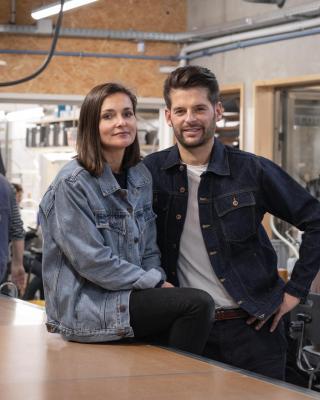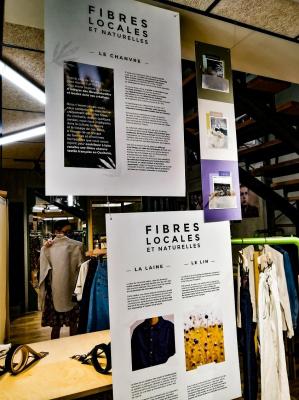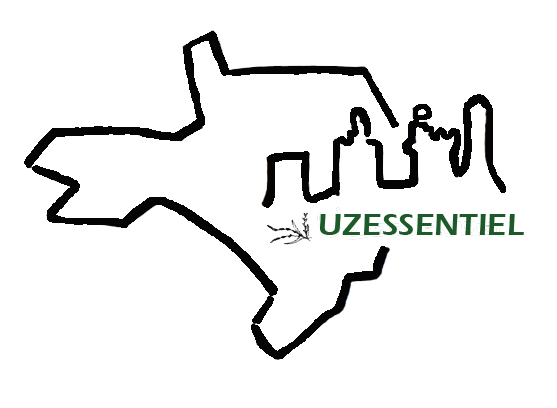Atelier TUFFERY, a family French know how in Florac (part 1)
FR - Proud of the expertise of previous three generations, the Atelier TUFFERY in Florac cultivates French handmade denim.
With the desire to maintain a traditional factory in the heart of the Occitan region, while drawing on the expertise of regional partners, such as raw materials from Brittany and Tarn, and the partnership with Maison Fabre in Aveyron, The Atelier TUFFERY is also a major economic player in Lozère.
GUIDED TOUR
 Hello Myriam, and welcome to the Lifestyle section of the blog,
Hello Myriam, and welcome to the Lifestyle section of the blog,
You and your husband took us on a guided tour of the Atelier TUFFERY. Thank you very much for this wonderful insight into your daily life.
Atelier TUFFERY is a family business founded in Florac in 1892 by ‘Célestin Tuffery, a true pioneer of French denim’. At the end of the 19th century, he ‘began by creating a functional and robust indigo-dyed work garment’, marking the very beginning of the Cévennes denim.
Now it's your turn, as the 4th generation, to carry on the family tradition of quality. Was the decision to take over the business a natural one, or was it a change of direction?
We were both in interesting management and engineering positions when the question of taking over the family business arose. So you have to ask yourself ‘But what about this takeover madness’, when craft and manufacturing activities 10 years ago in France were not very popular?
The 3rd generation, the ones that preceded us (Julien's father and uncles) were resilient. Despite the difficulties faced by the textile sector following the waves of globalisation and relocation of textile production that began in the 1970s, they never stopped producing. Despite this, Julien, like many sons of craftsmen born in the 80s, was not at all encouraged by his parents to learn the trade of tailor-confectioner. At the time, it was no longer a career with a future. Good at school, he followed a traditional scientific stream and became an engineer in water treatment and environment. With a career in a major group that had started well, nothing predisposed him to take over the family business.
In short, his university career was similar to mine. I studied at the same engineering school, taking an agri-food course myself and, at the time, thinking about whether it would be a good idea to take on a position of responsibility.
Like many working people today, we were increasingly finding that there was a significant gap between the decisions taken at the highest levels and our common sense: our place, our usefulness to society through our careers and, more generally, our impact on the planet. We were increasingly interested in the provenance of consumer goods and questioning established systems, such as ‘Why does a product circle the globe three times before reaching our cupboards? or ’What is the real price of a product, what are the value chains?
This quest for meaning was echoed in 2012 with the boom in communication around made in France. The issue of product traceability, the reindustrialisation of France and responsible consumption became increasingly important.
With all these indicators in the green, and after a lot of behind-the-scenes work, passing on and thinking about creating a suitable and innovative business model, in 2016 we (officially) bought and redeveloped the Tuffery company.
A fresh start! We wanted an innovative manufacturer that put people at the heart of the business, with the mantra that the hands that make are the hands that sell. In conclusion, responsible, transparent manufacturing, with a value chain that is as efficient as possible in environmental and social terms, without reducing the quality or aesthetic appeal of our products.
|
Good to know:
Atelier TUFFERY will be at the Saveurs et Savoirs Festival in Uzès from 10 to 13 October,
for the second year.
And in a temporary boutique in Aix-en-Provence from 28 September to 5 October.
|
Customer needs and expectations have changed over the years and even become more refined. Nowadays, quality has to go hand in hand with ethics and being made in France.
How did you define the innovations you wanted to bring to the brand and its production? How do your husband's father & uncles, who still work in the workshop, support you in your quest for excellence? For example, do they advise you on the choice of fabrics, suppliers and improvements to production, sharing their wealth of experience with you?
Of course, our greatest asset, as the 4th generation, has been to dust off this historic craft of tailoring and making, by using the most modern digital tools and solutions to bring out the best in traditional craftsmanship.
Our strategy of direct sales has enabled us to remain based in Florac, in the heart of the Cévennes, and to use the web to offer our entire wardrobe in France and abroad.
As I said, ‘the hands that work are the hands that sell’. Cutting out the middleman is an ethical and responsible way of selling at the right price, since the entire selling price goes back to the workshop. In this way, we ensure that the workforce is properly paid and can work in good conditions.
This has been our strategy and our winning bet in relaunching this century-old factory while modernising it. Our products are modern and trendy, responding to both urban and classic styles.
We've had a lot of handing down from the previous generation (pattern-making, archives of cuts from the 60s to the 80s, tailoring, training in cutting and tailoring, etc.), professionals who are still with us in the workshop.
 You've opted for local, natural fibres like hemp, linen and wool. What is your selection process, and how do you choose your partners?
You've opted for local, natural fibres like hemp, linen and wool. What is your selection process, and how do you choose your partners?
We're convinced that in 20, 30 or even 50 years' time, it will be much harder to get cotton, the most economical plant fibre used in the globalised textile world, to travel. And our common sense, like that of our ancestors, led us to opt very early on for ‘more’ local fibres such as hemp, flax and wool, all of which are local resources. In particular, wool and hemp from the Occitania region.
When we took over, the French textile industry was moribund. We gave new impetus to the ‘100% ecological, ethical and socially responsible’ textile industry with SCIC VirgoCoop, a Cooperative Society for Collective Interest of which we are founding members along with other great people like Mathieu Ebbesen. We were all driven by our commitment to responsible fashion, by fundamentally changing the systems in place in the textile industry.
Hemp and flax are environmentally very interesting plants (low water consumption, no chemical inputs, well grown in France). The hardest part was re-internalising the steps involved in turning the fibre into yarn for weaving. We worked hard and invested a lot alongside VirgoCoop to coordinate all this. A defibration plant has recently become operational at Caylus in the Tarn, close to a large hemp mill. It's unique in France.
Wool is a local resource that has always been abundant in Lozère. It is a rustic wool from Lacaune ewes (dairy sector). For years, this wool has been considered a waste product, a by-product. So we've turned the tables, and for the last 4 years we've been running a genuine recycling network. A set of best practice specifications, a group of motivated farmers, a team of shearers, coordinated together with VirgoCoop, enable us to harvest 13 tonnes of raw wool, bought from the farmer at 5 times the market price.
The wool is then washed in Saugues, in the Haute-Loire, and spun in Ariège at the Dreuilhe spinning mill. The weaving is done in the Tissages d'Autan workshop in Castres in the Tarn, as is the dyeing in Aussillon at Etablissements Plo.

Digitised patterns, but manual cutting. How do these two techniques complement each other?
They are two independent things. The digital shift we made 7 years ago when we took over has enabled us to continue our development. The craftsmanship is still very much present, because we have kept and anchored the patterns from our forefathers' work (their industrial techniques, their cuts, their gradations...). But we have adapted this heritage to more modern practices, which save us time today and enable us to be competitive in the clothing and fashion market, while offering over 70 references in our wardrobe today.
In any case, it takes expertise and the human hand to work the placements digitally, quilt and make a precise manual cut. This way of doing things fits in well with our manufacturing practices in our workshop today... (to be continued in part 2).
 Many thanks to Myriam for her collaboration on this article and for her warm welcome and personalised guided tour of the workshop.
Many thanks to Myriam for her collaboration on this article and for her warm welcome and personalised guided tour of the workshop.
Photo credit Myriam and Julien©Ben Perrier, Photo credit Atelier©O.F Visuels.
The right address: Atelier - Boutique TUFFERY, ZA Saint-Julien-du-Gourg, 48400 Florac. Open Monday to Saturday, 9am to 12pm and 2pm to 7pm. Boutique de Montpellier - Atelier TUFFERY, 13 boulevard du jeu de paume, 34000 Montpellier. Open Tuesday to Saturday from 10am to 7pm. Follow @Atelier de Tuffery on Instagram and Facebook.






